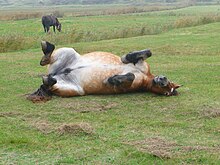Pangaré



Pangaré is a coat trait found in some horses that features pale hair around the eyes and muzzle and underside of the body. These pale areas can extend up to the flanks, throat and chest, behind the elbows, in front of the stifle, and up the buttock.[1] Animals with the pangaré trait are sometimes called "mealy" or "light-pointed". The color of these lighter areas depends on the underlying color and ranges from off-white to light tan.[2] This type of coloration is most often found in primitive breeds like the Fjord horse, Exmoor Pony, American Belgian Draft, and Haflinger. Wild equids like the Przewalski's Horse, Onager, African Wild Ass, Kiang as well as the domestic Donkey exhibit pangaré as a rule.[3] Pangaré is thought to be a type of protective countershading.

Horse foals are often born with "foal pangaré" or light points, especially over black haired areas, which they lose when they shed their foal coats.
Dr. Phillip Sponenberg suggested that the seal brown coat color was caused by the action of pangaré on a black coat.[4] However, seal brown horses have since tested negative for the recessive black agouti genotype.[5]
Chestnut horses with pangaré are sometimes called "Belgian sorrels".
In donkeys, no light points (loss of pangare) is caused by a recessive missense mutation at agouti. The light points (pangare) color is similar to the light bellied agouti color in mice, while the no light points color is similar to recessive black in mammals.[6] In light bellied agouti mice, the agouti mRNA starts with a different noncoding exon depending on whether it is made in the dorsal or ventral region. This leads to a lighter belly color in mice and probably other mammals as well.[7]
References[]
- ^ Marcia Stacy. "Pangare (mealy)". Icelandic Horse Colors. Archived from the original on 2003-04-28. Retrieved 2008-06-26.
- ^ "Mealy/Pangare (Other Modifiers)". Equine Color. Nov 2003. Archived from the original on 2008-05-17. Retrieved 2008-06-26.
- ^ Leah Patton. "Pangare - Extensive "mealy points" on Mules". The Mule Info Page. Archived from the original on 2009-10-22. Retrieved 2008-06-26.
- ^ Sponenberg 2003. pg. 29. "Some horses referred to as brown are essentially black but have the mealy effect superimposed. Such horses are called seal brown. Seal browns and very darkly countershaded browns can look almost identical and illustrate that occasionally it is difficult to assess a horse's genotype accurately by visual inspection of phenotype alone."
- ^ Rieder, Stefan; Sead Taourit; Denis Mariat; Bertrand Langlois; Gérard Guérin (2001). "Mutations in the agouti (ASIP), the extension (MC1R), and the brown (TYRP1) loci and their association to coat color phenotypes in horses (Equus caballus)". Mammalian Genome. Springer-Verlag. 12 (6): 450–455. doi:10.1007/s003350020017. PMID 11353392. S2CID 2012676.
- ^ Abitbol, Marie; Legrand, Romain; Tiret, Laurent (2015). "A missense mutation in the agouti signaling protein gene (ASIP) is associated with the no light points coat phenotype in donkeys". Genetics Selection Evolution. 47: 28. doi:10.1186/s12711-015-0112-x. PMC 4389795. PMID 25887951.
- ^ Vreiling; Duhl; Millar; Miller; Barsh (1994). "Differences in dorsal and ventral pigmentation result from regional expression of the mouse agouti gene". PNAS. 91 (12): 5667–5671. Bibcode:1994PNAS...91.5667V. doi:10.1073/pnas.91.12.5667. PMC 44057. PMID 8202545.
- Horse coat colors
